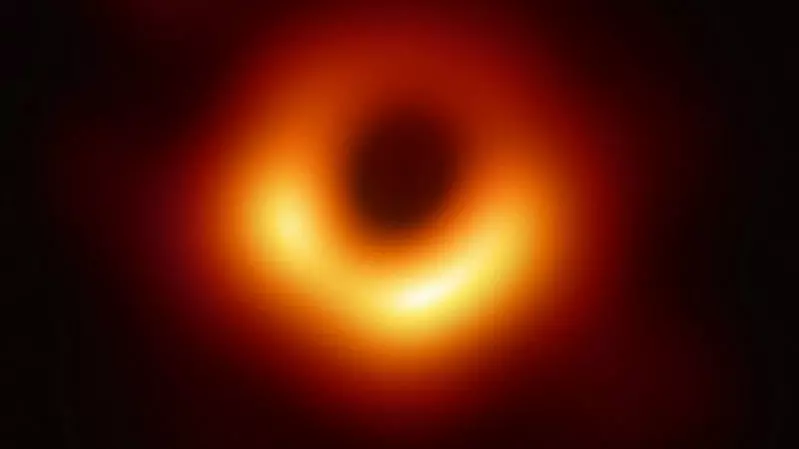It also provides significant insights into the workings of these space giants, which are thought to be located at the centers of most galaxies.
The film was created by experts from the worldwide event team “Event Horizon Telescope (EHT) Collaboration” based on data from a global network of radio telescopes grouped under the title EHT.
The first image of a black Sgr A * hole in the center of the galaxy
Photo: EHT collaboration
Scientists have long observed stars orbiting an invisible, compact, very massive body in the center of our galaxy. Based on these observations, they concluded that an object named Sagittarius A * (Sgr A *) may be a black hole.
Thus the film provides a long-awaited view, which is the first direct visual proof of the accuracy of this assumption.
It can not be seen directly, and the glowing gas around helps
Black holes generally distort light and time, and nothing, not even a gravitational wave, can escape from their center. Scientists from ESO, a member of the Czech Republic, reminded us in a press release that the black hole was so dark that we could not see it directly – as pointed out by the Institute of Astronomy at the Academy of Sciences in the Czech Republic. New success.
However, the glowing gas all around reveals indisputable signs of its presence: a dark center known as the shadow of a black hole and a bright ring around it. The image captures curved light rays in the strong gravitational field of the black hole, which is four million times larger than the Sun.
“We were amazed at how well the observed ring size matched Einstein’s theory of general relativity,” said Jeffrey Bower, an EHT scientist at the Academy of Astronomy and Astrophysics at the Academy of Sciences in Taiwan.
“These unprecedented observations have greatly improved our understanding of what is happening in the center of our galaxy and brought a whole new perspective on the interaction of giant black holes with the environment,” he added.
“Like a donut on the moon”
Because the black hole is located 27,000 light-years from Earth, the sky is about the same angular size as the “lunar surface donut”. To demonstrate this, experts have already created the powerful EHT Super Telescope, which connects eight radio telescopes around the planet. This created a unique virtual telescope with an imaginary diameter comparable to Earth.
Although the results are only now being reported, the EHT project tracked Sagittarius A * for several nights in 2017 and collected data for several hours in a similar manner to taking very long exposure photos.
The Milky Way and the location of the central black hole of our galaxy in the sky ALMA (Atacama Large millimeter / sub millimeter array)
Photo: ESO / Joseph Francis (josephrancisco.org), EHT collaboration
In addition to other facilities, the EHT Assembly includes the ALMA Observatory and the APEX Telescope in the Atacama Desert, Chile, which are co-owned and co-owned by ESO. Other companies with their equipment are also included in the project: the IRAM Radio Telescope in Spain and the NOEMA Antenna Array in France from 2018 onwards. The supercomputer used to integrate the data received by EHT operates at the Max Planck Institute in Germany.
“Over the past few years, ESO has played a significant role in discovering the secrets of black holes, especially the Sgr A * facility,” said Xavier Barcons, ESO Director-General.
The new success of the EHT project follows an image of a black hole published in 2019, located in the center of the galaxy Messier 87 (M87), about 55 million light-years away, which scientists now call the M87 *. At that time, it became the first “photograph” black hole.
Historically the first images of two black holes: M87 * on the left and Sgr A * on the right.
Photo: EHT collaboration
Despite the fact that the black hole in the center of the Milky Way is a thousand times smaller and less massive than M87 *, the two objects are very similar. “We have two different types of galaxies, two black holes and very different masses, yet they are almost identical,” said Sera Markoff of the University of Amsterdam in the Netherlands.
“This means that, when viewed closely, their behavior is governed by general relativity, and differences that can be observed at greater distances must be different properties of the material around black holes,” she said.
The gas blows very fast
However, although the Sgr A * object was very close, achieving this result was much more difficult than the M87 *. Chi-Kwan Chan, an EHT team scientist at the University of Arizona in the USA, explained that the gas near the black holes – at the core of the Galaxy M87 and Sgr A * – travels at about the same speed as light.
Comparison of sizes of supermassive black holes M87 * and Sgr A *
Photo: EHT collaboration (Author: Leah Mediros, xkcd)
“But in the case of the M87 *, a cycle can take anywhere from days to weeks, and in very small Sgr A * it’s just minutes. , “He likened.
Therefore, researchers need to develop sophisticated instruments that measure the movement of gas around the Sgr A * black hole. The M87 * was an easier and more sustainable target, where almost all images looked the same, and the situation was quite different with the Sgr A *. The Sgr A * image is the average of the various images selected by the team members to make the first appearance of a giant inhabiting the center of the galaxy.
In short, astronomers are happy to finally have images of two supermassive black holes with completely different masses, giving them the opportunity to understand how similar and how different they are.
The final image was created using an average of thousands of individual shots obtained using various computational methods based on observation data. Images can be divided into four groups according to the similar shapes they copy.
Photo: EHT collaboration

Problem solver. Incurable bacon specialist. Falls down a lot. Coffee maven. Communicator.



